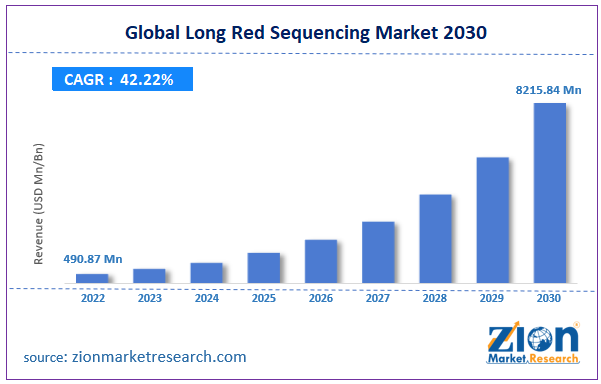🥤Long Red Sequencing Market Size, Share, Trends, Growth and Forecast (2022–2030)

The global long red sequencing market is expected to grow from its estimated USD 490.87 million in 2022 to USD 8,215 million by the end of 2030, according to a report released by Zion Market Research. Over the course of the projection period, the market is anticipated to expand at a CAGR of 42.22%. The growth factors, challenges, and effects on demand for the worldwide long red sequencing market are examined in this study for the period of forecasting. Additionally, it will support exploration and navigation of the emerging opportunities in the Long Red Sequencing Market sector.
✈👉Get a Free Sample: 🚀https://www.zionmarketresearch.com/sample/long-red-sequencing-market
Introduction
Long-read sequencing (LRS) is a cutting-edge technology revolutionizing genomic research and diagnostics by enabling the sequencing of longer DNA or RNA fragments, typically exceeding 10,000 base pairs. This contrasts with short-read sequencing, which struggles to capture complex genomic regions like structural variants, repetitive sequences, or large genes. LRS platforms, such as Pacific Biosciences (PacBio) and Oxford Nanopore Technologies, are widely adopted in applications including human genomics, microbial sequencing, and agriculture.
Overview of the Global Long Red Sequencing Market
The global long-read sequencing market has been experiencing rapid growth due to technological advancements, increasing demand for accurate genetic diagnostics, and rising investment in research and development. The market size, valued at approximately USD 1.2 billion in 2023, is projected to grow at a compound annual growth rate (CAGR) of 20% over the next decade.

The term “DNA sequencing method” refers to long-read sequencing. Known by another name, third-generation sequencing, it provides a number of benefits over existing next-generation sequencing techniques. With the same DNA sequence repeating throughout the genomes, it offers a more accurate DNA sequence. Compared to short-read sequencing, this direct sequencing technique enables the production of relatively longer reads. Due to its accuracy and affordability, the long read sequencing method in genomics has several uses for both model organisms and non-models.
Growth Factors for the Global Long Red Sequencing Market
One of the main reasons propelling the growth of the global long red sequencing market is the continuous advancements and innovations in third generation long-read sequencing techniques, which allow for higher read lengths and facilitate a comprehensive view of the entire genome. During the projection period, there will be a strong need for long-read sequencing due to the increasing prevalence of genetic illnesses worldwide. When examining genetic illnesses when the disease loci are known or highly suspected, the long read sequencing approach is frequently employed. These sequencing technologies can get beyond the fundamental drawbacks of next-generation sequencing.
One of the main advantages of long read sequencing over other methods is the use of long thread, which is generated from a single DNA molecule. The global long red sequencing market is growing as a result of increasing investments made by major industry players to support long-read sequencing technology research & development. The cost of the sequencing run has been greatly reduced by the real-time sequencing capability, which did away with the need for batch sampling. As a result, in a time-sensitive setting, the technology is heavily employed in the examination of newly collected samples as well as ones that have not yet been examined.

Segmentation of the Global Long Red Sequencing Market
Segments such as end users, workflows, applications, products, technologies, and regions can be used to analyze the worldwide long red sequencing market.
The market can be divided into pharma and biotech companies, clinics and hospitals, academic and clinical research, and other end-user segments. Because there are so many biotechnology centers that study molecular biology and genome sequencing, the academic research segment holds the greatest proportion of the worldwide long red sequencing market. Additionally, during the projection period, the growing use of sequence analysis techniques in academic scientific research and on-site bioinformatics courses offered by various universities is driving the segment’s growth.
The market may be divided into data analysis, sequencing, and re-sequencing workflows. The global long red sequencing market is dominated by the sequencing sector.
The market can be divided into segments based on applications, such as identification and file mapping of structural variation, cancer, resolving allele phasing, tandem repeats sequencing, viral and microbial sequencing, and reproductive genomics. The global long red sequencing market is dominated by structural variation segment identification and file mapping.
The market can be divided into services, consumables, and instruments based on the product.
The market can be divided into two segments based on technology: single-molecule real-time sequencing and nanopore sequencing. The consumables market dominates all others.
✈👉Directly Purchase a copy of the report with TOC: 🚀https://www.zionmarketresearch.com/toc/long-red-sequencing-market
Market for Long Red Sequencing: Report Scope

Regional study of the global market for long red sequencing
Because there are so many major market competitors in North America, the region has the greatest share of the worldwide long red sequencing market. The region’s government authorities’ approval and use of genetic tests within a well-regulated framework also contributes to the expansion of the regional market. Over the course of the projection period, the region’s expanding demand for genomic procedures for clinical and academic use will also drive the expansion of the regional market.
Asia Pacific is anticipated to develop significantly throughout the projection period as a result of the region’s increasing investments and technological advancements.
Key Drivers
- Rising Demand for Precision Medicine: Long-read sequencing has significantly contributed to personalized healthcare. By identifying genetic mutations more accurately, LRS plays a vital role in detecting rare genetic disorders, cancers, and drug-resistant bacteria.
- Technological Advancements: Continuous improvements in LRS technology have made it more accessible and cost-effective. PacBio’s HiFi reads, for instance, combine the accuracy of short reads with the advantages of long-read sequencing.
- Growth in Genomics Research: The increasing importance of genomics in agriculture, pharmaceutical development, and environmental science has driven demand for advanced sequencing technologies. LRS is indispensable for studying plant genomes, where high-quality assemblies are necessary for crop improvement.
- Increasing Government Support: Governments and healthcare organizations are investing in genomics and precision medicine, further boosting the adoption of LRS technologies.
Challenges
- High Costs: Despite advancements, LRS technologies remain relatively expensive compared to short-read alternatives, limiting adoption in smaller research labs and institutions.
- Data Management and Interpretation: The vast data generated from long-read sequencing can be challenging to store, process, and interpret, requiring robust bioinformatics tools and skilled personnel.
- Competitive Pressure from Short-Read Sequencing: Short-read sequencing, led by Illumina, remains the industry standard for many applications due to its lower costs and high accuracy for smaller, well-defined regions of the genome.
Market Segmentation
The long-read sequencing market can be segmented into the following categories:
- By Technology:
- Single Molecule Real-Time (SMRT) sequencing
- Nanopore sequencing
- By Application:
- Human genomics
- Cancer research
- Agriculture genomics
- Infectious disease research
- Others (plant genomics, environmental studies)
- By End-User:
- Academic and research institutions
- Hospitals and diagnostic laboratories
- Pharmaceutical and biotechnology companies
- Agricultural organizations
Regional Insights
- North America: The largest market for long-read sequencing, driven by strong investment in genomics research, healthcare infrastructure, and pharmaceutical R&D.
- Europe: Increasing genomics research and collaboration between academic institutions and industry partners have fostered growth in the region.
- Asia-Pacific: Rapidly growing markets, such as China and India, are expected to contribute significantly to market expansion due to their increasing focus on precision medicine and agricultural biotechnology.
Competitive Landscape
Key players in the long-read sequencing market include:
- Pacific Biosciences (PacBio): A leader in SMRT sequencing technology, PacBio offers high-fidelity long reads ideal for complex genomic research.
- Oxford Nanopore Technologies: Known for its portable sequencing devices and versatility, Oxford Nanopore’s technology is being adopted for real-time, field-based research in areas like epidemiology and conservation biology.
- Illumina: Though primarily a short-read sequencing provider, Illumina is investing in long-read technologies to expand its portfolio and remain competitive.
- 10x Genomics: Specializes in combining long-read data with high-throughput capabilities, offering innovative solutions in single-cell and spatial genomics.
Future Outlook
The long-read sequencing market is poised for robust growth, driven by its application in personalized medicine, agriculture, and research. Innovations aimed at reducing costs, improving read accuracy, and enhancing bioinformatics tools will further accelerate adoption. Additionally, collaborations between academic institutions, healthcare providers, and industry players will continue to expand the reach and capabilities of LRS technologies.
Conclusion
As the long-read sequencing market evolves, it will play an increasingly important role in advancing genomic research, diagnostics, and therapeutics. While challenges such as cost and data complexity remain, ongoing innovation and investment are expected to drive significant growth in the coming years, making LRS a cornerstone of future biological discoveries.
✈👉Enquiry for buying: 🚀https://www.zionmarketresearch.com/inquiry/long-red-sequencing-market
Find out more👇
Global Agricultural Testing Market
Contact Us:
Zion Market Research212
USA/Canada Toll Free: 1 (855) 465–4651
Newark: 1 (302) 444–016611\
Web: https://www.zionmarketresearch.com/
Blog: https://zmrblog.com/
Comments
Post a Comment